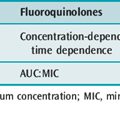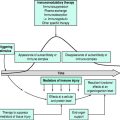Chapter 58 Anaphylaxis
Anaphylaxis is a symptom complex accompanying the acute reaction to a chemical recognised as hostile. In the classical reaction the patient has been previously sensitised (immediate hypersensitivity or type 1 hypersensitivity), although the sensitising agent may be unknown. The term ‘anaphylactoid reaction’ is used to describe reactions clinically indistinguishable from anaphylaxis, in which the mechanism is non-immunological, or has not been determined. Recent consensus meetings have suggested the use of the term ‘anaphylactoid’ be discontinued and ‘anaphylaxis’ used to describe the symptom complex which may be either ‘non-immune’ or ‘immune’.1 Non-immune anaphylaxis may be produced by direct drug effects, physical factors or exercise, and a causative agent cannot always be determined. The mediators involved are the same as those in other acute inflammatory responses such as sepsis, but the rate of release is more rapid and of shorter duration.
AETIOLOGY
Neugut et al.2 estimated 1400–1500 deaths per year in the USA and between 3.3 and 40.9 million patients at risk. They estimated radiocontrast media and penicillin to be the greatest cause of death, with food and stings the next groups. In contrast a postmortem study of 56 deaths in the UK3 attributed 19 deaths to venoms, 16 to foods and 19 to drugs and radiocontrast media.
The direct histamine-releasing effects of some drugs may produce reactions due to the effect of histamine alone, and such reactions are related to volume, rate and amount of infusion. Recent work suggests that the site of release of histamine may be important in its clinical effects. Drugs such as morphine and Haemaccel release histamine from skin alone,4 and are unlikely to produce symptoms such as bronchospasm, whereas drugs which produce release from lung mast cells (e.g. atracurium, vecuronium and propofol) may be more likely to produce bronchospasm.5 Direct histamine release is usually a transient phenomenon, but in some patients severe manifestations may occur, particularly with Haemaccel and vancomycin.
Anaphylactic reactions are usually seen in fit and well patients. It is likely that the adrenal response to stress ‘pretreats’ sick patients, and blocks the release and effects of anaphylactic mediators. The exception to this appears to be patients with asthma, in whom reactions to the additives in steroid and aminophylline preparations may occur, and this may be related to the reduced catecholamine response in asthma.6 Patients on β-blockers and with epidural blockade may be more likely to develop adverse responses due to histamine release, and this may also be related to reduced catecholamine responsiveness. Reactions occurring in these groups are more difficult to treat.
CLINICAL PRESENTATION
The latent period between exposure and development of symptoms is variable, but usually occurs within 5 minutes if the provoking agent is given parenterally. Reactions may be transient or protracted (lasting days), and may vary in severity from mild to fatal. Recurrent anaphylaxis is described. Cutaneous, cardiovascular, respiratory or gastrointestinal manifestations may occur singly or in combination.
Cutaneous features include piloerection, erythematous flush, generalised or localised urticaria, angioneurotic oedema, conjunctival injection, pallor and cyanosis. Awake patients may experience an aura, warning of an impending reaction. Cardiovascular system involvement occurs most commonly and may occur as a sole clinical manifestation.7 It is characterised by initial bradycardia then sinus tachycardia, hypotension and the development of shock.
In patients reacting due to venom desensitization, bradycardia may be severe and require treatment.8 Respiratory manifestations include rhinitis, bronchospasm and laryngeal obstruction. Gastrointestinal symptoms of nausea, vomiting, abdominal cramps and diarrhoea may be present. Other features include apprehension, metallic taste, choking sensation, coughing, paraesthesiae, arthralgia, convulsions, clotting abnormalities and loss of consciousness. Pulmonary oedema is a rare sign. Rarely, some women develop a profuse, watery, vaginal discharge 3–5 days after anaphylaxis. It is self-limiting.
PATHOPHYSIOLOGY OF CARDIOVASCULAR CHANGES
Whether or not cardiac function is impaired has been controversial. Although most anaphylactic mediators adversely affect myocardial function in vitro, most case reports of anaphylaxis in which invasive cardiovascular monitoring has been used suggest minimal impairment of cardiac function. Patients with normal cardiac function before the reaction rarely show evidence of cardiac failure or arrhythmias other than supraventricular tachycardia, but the incidence of serious arrhythmias and cardiac failure increases in those with prior cardiac disease.7 Echocardiography in anaphylaxis usually shows an ‘empty’, normally contracting heart. Troponins are elevated after anaphylaxis, but these elevations do not normally predict coronary artery disease requiring intervention. A recent study of patients with anaphylaxis during venom desensitisation showed that bradycardia requiring treatment was a common finding.8 Two reactions in patients with no previous cardiac disease, where the major manifestation was prolonged global myocardial dysfunction, and the use of a balloon counterpulsator was life-saving, have been reported.9
TREATMENT
OXYGEN
Oxygen is given by facemask. Endotracheal intubation may be required to facilitate ventilation, especially if angioedema or laryngeal oedema is present. Oedema of the upper airway is more common when anaphylaxis is due to foods than to drugs.3 Mechanical ventilation is indicated for severe bronchospasm, apnoea or cardiac arrest.
ADRENALINE (EPINEPHRINE)
Epinephrine is universally recommended as the drug of choice for severe reactions. In the community epinephrine may be given intramuscularly in a dose of 0.3–1.0 mg early in anaphylaxis. Intramuscular epinephrine produces higher levels earlier in stable allergic patients than subcutaneous epinephrine.10 In severe shock or in patients in whom muscle blood flow is thought to be compromised by shock, intravenous injection of 3–5 ml of 1:10 000 epinephrine is given. A second dose is necessary in 35%11 and an infusion in 10%.
There has been controversy regarding the best route of administration of epinephrine outside hospital. Both case reports and patients self-injecting show efficacy for intramuscular epinephrine when given early. Intravenous epinephrine may rarely cause arrhythmias and myocardial infarction, particularly in unmonitored patients. In our series it seems to be more hazardous when the diagnosis of anaphylaxis is incorrect. Recent recommendations endorse the use of intramuscular epinephrine.12
COLLOIDS
Plasma expanders are given rapidly to correct the hypovolaemia consequent to acute vasodilatation and leakage of fluid from the intravascular space.13 The author favours plasma protein solution or gelatin preparations rather than crystalloids, as they remain in the vascular compartment earlier and for longer. There are, however, no data showing improved outcomes from colloid over crystalloid, and there are many patients who have been successfully resuscitated with crystalloid alone. Greater volumes of crystalloid are necessary and on occasions very large volumes of fluid may be required; central venous pressure monitoring and measurement of haematocrit are helpful.
BRONCHOSPASM
Epinephrine should be given. Nebulised salbutamol should be given for severe asthma. Aminophylline 5–6 mg/kg intravenously may be given over 30 minutes, if bronchospasm is unresponsive to epinephrine alone. Aminophylline increases intracellular cAMP by phosphodiesterase inhibition, and its effect on inhibiting histamine and interleukin release is theoretically additive to that of epinephrine. Adverse responses have not been observed in our series but a recent comprehensive review14 suggested safer agents with proven efficacy should be preferred. Volatile anaesthesia, ketamine and magnesium sulphate may produce improvement in some patients with severe asthma.
DIAGNOSIS
The most important advance in the diagnosis of anaphylaxis has been the introduction of an assay for mast cell tryptase. The mast cell enzyme is elevated 1 hour after a reaction begins, and the elevation may persist for up to 4 hours. It can also be used to diagnose anaphylaxis from postmortem specimens.15,16 The assay is highly specific and sensitive for anaphylaxis, although elevated levels are found with direct histamine release, and at postmortem in some patients with myocardial infarction. A negative mast cell tryptase assay does not exclude anaphylaxis as the diagnosis. Mast cell tryptase has been used to diagnose anaphylaxis postmortem.
1 Sampson HA, Munoz-Furlong A, Campbell RL, et al. Second symposium on the definition and management of anaphylaxis: summary report. Second National Institute of Allergy and Infectious Disease/Food Allergy and Anaphylaxis Network symposium. J Allerg Clin Immunol. 2006;117:391-397.
2 Neugut AL, Ghatak AT, Miller RL. Anaphylaxis in the United States: an investigation into its epidemiology. Arch Intern Med. 2001;161:15-21.
3 Pumphrey RS, Roberts IS. Postmortem findings after fatal anaphylactic reactions. J Clin Pathol. 2000;53:273-276.
4 Tharp MD, Kagey-Sobotka A, Fox CC, et al. Functional heterogeneity of human mast cells from different anatomic sites: in vitro responses to morphine sulphate. J Allergy Clin Immunol. 1987;79:646-653.
5 Stellato C, de Paulis A, Cirillo R, et al. Heterogeneity of human mast cells and basophils in response to muscle relaxants. Anesthesiology. 1991;74:1078-1086.
6 Ind PW, Causon RC, Brown MJ, et al. Circulating catecholamines in acute asthma. Br Med J. 1985;290:267-269.
7 Fisher MM. Clinical observations on the pathophysiology and treatment of anaphylactic cardiovascular collapse. Anaesth Intens Care. 1986;14:17-21.
8 Brown SG, Blackman KE, Stenlake V, et al. Insect sting anaphylaxis; prospective evaluation of treatment with intravenous adrenaline and volume resuscitation. Emerg Med J. 2004;21:149-154.
9 Raper RF, Fisher MM. Profound reversible myocardial depression following human anaphylaxis. Lancet. 1988;8582:386-388.
10 Simons FE, Roberts JR, Gu X, et al. Epinephrine absorption in children with a history of anaphylaxis. J Allergy Clin Immunol. 1988;101:33-37.
11 Korenblat P, Lundie MJ, Dankner RE, et al. A retrospective study of epinephrine administration for anaphylaxis: how many doses are needed. Allergy Asthma Proc. 1988;20:83-86.
12 Project team of the Resuscitation Council UK. Emergency medical treatment of anaphylactic reactions. Resuscitation. 1999;41:93-99.
13 Fisher MM. Blood volume replacement in acute anaphylactic cardiovascular collapse related to anaesthesia. Br J Anaesth. 1977;49:1023-1026.
14 Ernst ME, Graber MA. Methylxanthine use in anaphylaxis: what does the evidence tell us? Ann Pharmacother. 1999;33:1001-1004.
15 Yunginger JW, Nelson DR, Squilace DL. Laboratory investigation of deaths due to anaphylaxis. J Forensic Sci. 1991;36:857-865.
16 Fisher MM, Baldo BA. The diagnosis of fatal anaphylactic reactions during anaesthesia: employment of immunoassays for mast cell tryptase and drug-reaction IgE antibodies. Anaesth Intens Care. 1993;21:353-357.







